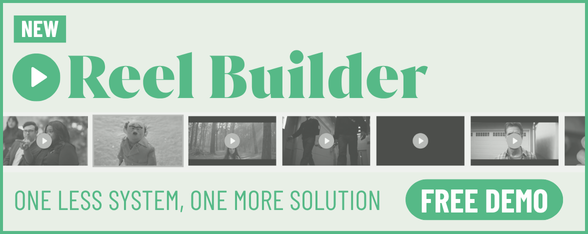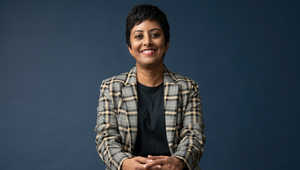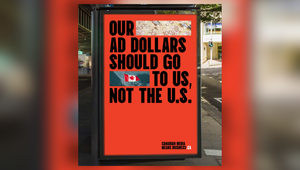
Sustainability x Advertising: “Advertising is One of the Major Funders of Extreme and Misinformative Content”

Throughout our series on joining the dots on the climate crisis and sustainability across the advertising industry, we’ve seen Clean Creatives take on the oil giants and Purpose Disruptors urge agencies to work with clients to embed sustainable lifestyles and behaviours in their briefs. For the next piece in the puzzle, we’re talking to CAN’s Harriet Kingaby to unpick the more subtle ways that the edifice of advertising is feeding into and even creating a self-reinforcing system of misinformation and mistrust, favouring false news over hard science on climate change.
Conscious Advertising Network is a coalition of over 70 organisations trying to make sure that the industry’s ethical practices keep apace with developing technology. Their remit certainly isn’t limited to sustainability but it’s a key area of concern. The good news is that there’s lots of different ways that agencies and advertisers can be more conscious of their impact on sustainability – whether it’s around their media investment, the influence they can wield over platforms and other vendors in their supply chain or, indeed, the creative reframing of sustainable behaviours as aspirational.
Amélie Lambert caught up with Harriet Kingaby, who is co-chair of Conscious Advertising Network and insight director at Media Bounty, to dig into the toxic systems being propped up by the industry – and to shine the light on some glimmers of hope.
Amelie> Why does the Conscious Advertising Network exist? And what challenges are you working on?
Harriet> Our mission statement is to ensure that ethics catches up with the technology of modern advertising. What that means is that we exist to break the economic link between content that divides us, misinforms us and harms us, and advertising that is creating the perverse financial incentives that are fueling that.
There’s two elements to this. The first is that advertising is, unfortunately, funding misinformation. Some people think up to $2.6 billion every year [is being funnelled from big brands to misinformation websites]. So, a lot of money. But it is also inadvertently starving hard news, and things like factual climate reporting and diverse communities of funding for their media. The reason behind that is that this kind of content is deemed ‘brand unsafe’, because it deals with issues which are emotional, pithy and complex - and risk-avert advertisers are deciding that they don't want to go there.
Or they're devolving responsibility to technology platforms who are saying, this is a risky place for your advertising to be.
What we exist to do is promote something called ‘conscious media investment’, where we're making advertisers think really consciously and carefully about what they're investing in with their media spend, and therefore create a healthier media environment, where we can make much better informed decisions and have better debates about important issues like climate change.
Amelie> How do you track and measure that investment? How does the financial measurement happen logistically?
Harriet> Those figures above were from an organisation called NewsGuard. What they do is they classify the quality of news sites based on various indicators. Organisations like News Guard look at how much advertising they find on sites which cross the line into hate speech or harm. The estimates they make can vary. There’s also the Global Disinformation Index.
What we do know is that advertising is one of the major funders of extreme and misinformative content. The reason for this is that salacious, shocking and misinformative content flies through our social media platforms six times quicker than the truth, according to a MIT study from a couple of years ago. It makes it very lucrative. So, if you've got content that's got lots of eyeballs and lots of people searching for it and commenting on it, even if they’re hate comments, it makes it attractive for advertisers. Many think that's where our advertising should be. You have whole industries that are popping up around this. Some of our pundits that we see spouting untrue and harmful stuff are getting very well paid to do so.
We also know that there are groups of people who usually wouldn't earn much money, for example, in Macedonia, where the Pizza Gate story started, who are setting up sites, specifically to create misinformation that's really shocking, so they can earn some money. We've got lots of different people creating misinformation for lots of different reasons – all underpinned financially by advertising.
On the flip side of that, if we look at the most shared factual climate content online, the stuff that people really are interested in, we find that 70% of that is not monetizable through advertising. That's really shocking, right? It means that if you want to say climate change is a hoax, and it's perpetrated by Hillary Clinton in a basement somewhere, there's lots of opportunities for you to monetize that. But if you are factually reporting what's happened from an IPCC report, it's quite difficult. There's a disincentive there, because if you run a piece on it, it's likely that lots of brands will block that piece, and it won't be able to monetize it. We're creating this skewed debate where it's more profitable to create rubbish than it is to report factually around climate.
Amelie> You talked about conspiracy theories being more lucrative and traveling six times faster, because they're better stories. What do you think is currently missing in our storytelling, from the ad industry's stand point? What does it take for our master storytellers to bring people on board, reverse that trend and make climate action the more likely course of action?
Harriet> We talk about three different aspects of conscious advertising: there’s conscious investment, which is the media piece I've talked to you about. Then conscious creative, which is about sustainable lifestyles, reframing things and talking about opportunities for us and a better future for our kids. And then we also talk about conscious influence - the ability of the advertising industry to influence things like the platforms. Because the platforms are where a lot of these stories are being told and adapted.
I think we used to think as advertisers that it was our creativity that changed the world. And now we know that it's a combination of our creativity, our media placement, and what we choose to do with the influence power that we have. Let's not forget that advertisers are these platform's biggest customers, and therefore we have a huge responsibility to use that influence to clean them up.
Amelie> Even the mainstream media, respected media, will sometimes be choosing more sensational, gripping titles for clickbait because everybody is competing for our attention. How do you even reverse such a trend at that level?
Harriet> You're absolutely right. What's happened is that advertising and the fight for people's attention has fundamentally changed the way that we tell stories. We now create clickbait in order to get people to click and react. And we change the way we story tell, we tell things with much pithier or perhaps we bring in a celebrity that wasn't even there so that we improve our SEO.
We feel that advertisers need to be thinking beyond attention. They need to be thinking about quality in the way that they place their ads. That works for them in a commercial sense, because quality news outlets have longer dwell times, we spend longer there considering the information. Because of that, consumers recall the advertising better, especially when we see it in a more trusted environment. So, from a commercial perspective, it’s important to think about quality environments.
From a fixing our media environments perspective, that should work because if there is a premium on good reporting and advertisers are willing to invest and consciously think about that, then you create a different market dynamic, which then starts to address some storytelling issues that we've talked about.
It’s about changing the incentives. If you change the incentives, that has a knock on effect on the quality of reporting and storytelling that we see. A lot of what we're doing is trying to fix this reliance on algorithms and programmatic placement and switching things up as soon as created.
Amelie> How do brands facilitate that change through the procurement process and criteria?
Harriet> We believe that advertisers have the power within their supply chain. It's advertisers' brands that are going to be appearing next to this hateful content, their logo, their strapline, their creative that is appearing in the wrong place. Also, it's their money that's been spent by vendors that they take on.
We’ve created these six manifestos (and a seventh one on climate and sustainability) and we say, embed the principles of these manifestos within your procurement process.
So, whenever you're bringing on a new vendor, whenever you're bringing on a new agency, or a new ad tech partner, you tell them ‘this is how we want our advertising placed, created, bought and sold and it's in our contract’. Then you're changing the supply chain from that contract down. We want to change the default, because the default is really causing an impact on our media ecosystem, unless we start making these changes.
Amelie> That very much is sustainability language - get to the core of the system and embed that sustainability throughout. Looking at the advertising industry from a bird’s eye perspective, where do you think it's doing well on sustainability currently, and where is it falling short or even creating active harm?
Harriet> There are some brilliant initiatives within the advertising industry at the moment. And that's great, because for a long time, that wasn't enough. But unfortunately, a lot of it's about getting our own house in order. It happens to be about the carbon impact of production and the things that we need to think about when we're creating and sometimes placing advertising. We must do that - but let's not forget that the biggest impact of advertising is our brain print. The strength of this industry is in how it can change hearts and minds.
With that, if we are not portraying sustainable lifestyles within our advertising, if we are utterly reliant on fossil fuel clients, and we are putting our best people on that work, if we are not critically thinking about our clients and who they are, it is difficult to make those changes from the ground up. Things like the Change the Brief Alliance is brilliant, but it's about trying to take clients on journeys.
We need to be leveraging what advertising does best, and thinking about changing that storytelling. We really need to be shifting our client base, we need to be creating a space where fossil fuel companies and high carbon industries who want to greenwash do not have access to the best minds. We need to be creating a space where we are not using our best minds to sell rubbish. We do need to have a collective moment of going, ‘we can't just keep selling stuff to people that they don't need, we can't keep creating demand for new stuff, because that is not compatible with a sustainable lifestyle’.
We already see where advertising can be useful in shifting categories - for example, electric vehicles. I also want to see less of us selling the latest fast fashion every three weeks, and more of us thinking we should be working with Depop instead, for example.
We need to think much more carefully about where our skills would be best to use. The original ASA new green claims paper that came out quite recently had a stat from the Climate Change Commission report from a few years ago, which said that, despite all of these efforts, there has been no change in carbon emissions from our own personal consumption over the last 10 years. That's ridiculous.
All of these companies and organisations are working to change personal behaviours, and we've not had a single bit of impact. That's just not good enough. A part of that is due to the greenwashing and misinformation we are creating. People are confused and advertisers need to do better in not creating that confusion. Advertisers need to be super clear and make sure that people really, really understand what we need to do collectively, and how they can pressure governments too. Let's not let governments and business off the hook here.
Amelie> That leads on to overconsumption, a well known dissonance in the advertising industry. Where do you draw the line of responsibility between the wider societal issue of overconsumption and our economy, effectively a growth economy of which overconsumption is a consequence? Advertising and marketing are just there to amplify those trends and not necessarily to change them. So how does cultural change happen in that wider context?
Harriet> Advertising has a huge role to play in terms of cultural change. We've seen examples from history where advertising has strongly either created an association with a behaviour or shifted the way that people see something. Let's not forget, on the less than fantastic side of things, that the reason we associate cigarettes with rebellion is because advertisers advertised them to suffragettes. We think about how the narrative around climate is stuck in this idea of personal carbon footprints and small personal actions.
We know that from the negative side of things, advertising has a huge role to play in setting frames and social norms. So we need the best minds in this industry to be thinking about and working on shifting norms and changing these things that will lead the transition. We also have a huge role to play in telling complete stories. We've seen the way climate has been communicated over the last few years, a real shift. It used to be about polar bears and landscapes, it's now much more than about us and our family and opportunity and our kids. That's been a master stroke, that kind of storytelling needs to continue and needs to diversify, needs to include the global picture.
We can influence the hearts and minds of entire nations with a big enough budget. So again, we have huge roles in building capacity within sectors and organisations who are looking at how you make that cultural shift.
Finally, there's a product issue. We know that with people switching to electric cars quickly, installing heat pumps and taking other energy efficiency measures, we can get to where we're going a lot quicker. There are huge roles there for the advertising industry. I think it's a tough brief to want to make insulation sexy, but let's see advertisers get involved with that. For me, it's about using mass tools to change sentiment around climate change and depict climate action as tangible and possible.
Amelie> From your standpoint, can we answer the question: is advertising inadvertently funding the Ukrainian war?
Harriet> I'll go back to two things. First, this funding model for hate and misinformation that advertising creates, that is very real. What I can tell you is that advertising will be a significant source of income for many people who are pushing out hate and misinformation. And even if it's not the main source of income, it will still be the one that enables the campaigns to continue. You think about some of the propaganda sites that have recently been defunded. They would have paid for themselves. So, if you've got a campaign that pays for itself, well, you can just keep spreading that hate and misinformation quite happily. When you think about where that misinformation comes from, we do know that some of it does come from the Russian government.
So, in that sense, yes, advertising is partially funding the machine behind that. Absolutely.
The second area I'd like to cover is ad fraud. Ad fraud is the second biggest funder of organised crime behind the drugs trade. And just the amount of money that is created by ad fraud is astronomical. Where that money is going, we genuinely don't know. So again, it's very possible that that money is going to nefarious actors.
Whilst we still have these two massive unresolved problems, then it's entirely possible that advertising is funding all sorts of horrible stuff. From hate to misinformation to organised crime, it could well be sponsoring state actors - we don't know because it's a big black hole. And that money comes from our favourite brands. It is delivered through ad tech systems that are making too much money to care. And it's facilitated by agencies that want to hit numbers. It's just not an acceptable situation.
Looking at the global and political moment that we are at right now, it is just not acceptable. We have got to fix it, because it is entirely possible that we are funding all sorts of horrible stuff.
Amelie> What recent development, in sustainability or in advertising or both, are you inspired or excited by?
Harriet> There is so much going on now that is exciting. I think that the last couple of years have been a real awakening, not only in terms of advertising's role and responsibility in fixing some of society's big problems, but particularly around climate. I think this year, we've heard the word sustainability and climate an awful lot, thank goodness. The things that are popping up are really radical and interesting.
Within mainstream advertising, we've got a lot of ‘getting our house in order’ to do and a lot of organisations that I would never have expected to be really championing this stuff, which is great. But we've also got those more radical fixes, asking the tough questions, and linking what we're trying to do to what we actually need to get done. Let's not forget that with the Paris Climate Agreement, we have got a roadmap, a plan, and an absolute imperative, on what we need to do and how quickly we need to do it.
So, for all of that activity to be aligned means an awful lot to me.
I think initiatives like the Purpose Disruptors feel really exciting. They are challenging the industry to do things like send our clients new briefs, take us to places, and are encouraging people to really think about how we want to use our collective skills, our brainpower. I think we've got lots of talent coming into the industry right now that doesn't want to work on fossil fuel advertising. This is brilliant and I'm loving stuff like Clean Creatives that's really engaging those new talents.
This grown-up conversation about misinformation and why our approach to brand safety is not enough feels really exciting to me as well. Actually, if we start to address that economic model, and we break the link between all of this free money which is available to people who are creating climate misinformation, then we really start to address the problem. All of this stuff happening together, feels like something is moving, something is shaking, and we're gonna get the results that we need to.
Amelie> In your own words, what would your main actionable takeaway be from our conversation for the Little Black Book audience?
Harriet> I think my one piece of advice would be to listen to your gut. Because if your gut is telling you something isn't quite right, it probably isn't. I think part of this collective realisation has been a lot of people whose guts aren't letting them go do the things that they were doing before anymore. Listen to your gut and ask questions. You will also find that there are a lot of people out there who are probably doing the same thing.
The beautiful thing about the way that CAN started was that a lot of people got together at a breakout session and all listened to their guts and went: ‘Something's not right, we need to do something about it’. I've never had a project start so easily. We just kept talking to other people who were feeling the same about this. I think now we're having that collective moment around climate of going "Something's not right. And we need to fix it."
Amelie> Any final thoughts?
Harriet> I just want advertisers to get on with it. We do so much pro bono work and we have all these awards, and we do stuff where we test what happens if our creativity knows no bounds. Let's direct that towards this enormous challenge, which is essentially changing and rewiring and reimagining and redesigning the way that we live our lives.
Imagine if we could get the amazing creative brains that we have in this industry behind that and excited by that. But also accountable to this big plan that we've got to keep the world under 1.5 degrees, because that is, in theory, the most juicy, beautiful, ridiculous challenge that's on the table today. We need all of us to shift things for the better.















